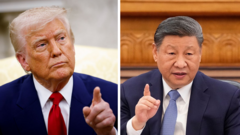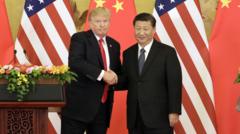The US and China have entered a truce to reduce tariffs on each other's goods, signaling a de-escalation in their ongoing trade war. This agreement, which includes a collective reduction in tariffs, aims to foster better trade relations and possibly set the stage for further negotiations.
US-China Tariff Truce: A Step Toward Trade Stability

US-China Tariff Truce: A Step Toward Trade Stability
The recent agreement between the US and China to lower tariffs marks a significant turn in the ongoing trade conflict, promising potential economic relief for both nations.
Article text:
In a noteworthy development, the United States and China have forged an agreement to lessen import tariffs on traded goods, indicating a truce in their ongoing trade confrontation. This resolution is seen as a pivotal move in de-escalating a conflict that has reverberated across the global economy, affecting trade flows and investor sentiment worldwide.
The details of the accord reveal that both countries will roll back some of the tariffs implemented amidst the previous tensions instigated by former President Donald Trump. Specifically, U.S. tariffs on Chinese imports will decrease from a staggering 145% to 30%, while China's tariffs on many U.S. goods will drop from 125% to 10%. Furthermore, China has suspended various non-tariff retaliatory measures, including the banning of essential mineral exports to the U.S., which were previously imposed in response to U.S. tariffs. It is noteworthy, however, that a 20% component aimed at pressuring China to take action against illegal fentanyl trafficking will remain intact.
This announcement followed the initial diplomatic discussions held in Switzerland, which were the first face-to-face talks between the two nations since the escalation of their trade tensions. As anticipation builds, questions arise regarding what the economic landscape looks like after the initial 90 days of this agreement. While it appears favorable now, the prospect of reinstatement of suspended tariffs looms overhead.
Economists suggest the trade truce could restore stability to the now strained commerce between the two leading economies, a reaction noted by several financial analysts. Some predict even if tariffs are reimposed after the designated period, they would revert only to 54% for U.S. imports from China and 34% for Chinese imports from the U.S. Such rates are significantly lower than what has been seen in recent months, prompting a sense of cautious optimism among market participants.
The types of goods exchanged between the nations are varied but substantial. In 2024, soybeans stand out as the largest export from the U.S. to China, predominantly for feeding China's vast livestock market, alongside pharmaceuticals and petroleum. Conversely, China exports a high volume of electronics and toys to the U.S., with smartphones being a significant category, notably with brands like Apple's iPhone leading the charge. Given that the U.S. imports from China ($440 billion) vastly outweigh exports to China ($145 billion), dissatisfaction from U.S. leadership regarding the trade imbalance has been a consistent theme, particularly under Trump's administration.
As each side seeks to claim a degree of victory from this truce, interpretations may vary significantly. In China, the sentiment may reflect a perception of strength in negotiations, as analysts suggest they may view the deal as a concession from the U.S. However, U.S. officials, including members of the Trump administration, celebrate this as an achievement, asserting that this agreement showcases the administration's negotiation prowess in favor of Americans.
Economists at Deutsche Bank provided insights implying that the recent tariff reductions, combined with previous agreements, might establish new upper and lower limits for U.S. tariffs, with the current arrangement setting significant benchmarks. The UK, comparatively balanced in trade relations with the U.S., has established a universal tariff rate of 10%, contrasting sharply with China’s higher tariff percentage, which underscores the imbalanced economic dynamics at play.
While the future remains uncertain, the agreement presents an opportunity for revitalization in U.S.-China economic exchanges. As discussions are set to intensify in the months ahead, the global economy remains watchful, hopeful for further cooperation between these two pivotal nations.
In a noteworthy development, the United States and China have forged an agreement to lessen import tariffs on traded goods, indicating a truce in their ongoing trade confrontation. This resolution is seen as a pivotal move in de-escalating a conflict that has reverberated across the global economy, affecting trade flows and investor sentiment worldwide.
The details of the accord reveal that both countries will roll back some of the tariffs implemented amidst the previous tensions instigated by former President Donald Trump. Specifically, U.S. tariffs on Chinese imports will decrease from a staggering 145% to 30%, while China's tariffs on many U.S. goods will drop from 125% to 10%. Furthermore, China has suspended various non-tariff retaliatory measures, including the banning of essential mineral exports to the U.S., which were previously imposed in response to U.S. tariffs. It is noteworthy, however, that a 20% component aimed at pressuring China to take action against illegal fentanyl trafficking will remain intact.
This announcement followed the initial diplomatic discussions held in Switzerland, which were the first face-to-face talks between the two nations since the escalation of their trade tensions. As anticipation builds, questions arise regarding what the economic landscape looks like after the initial 90 days of this agreement. While it appears favorable now, the prospect of reinstatement of suspended tariffs looms overhead.
Economists suggest the trade truce could restore stability to the now strained commerce between the two leading economies, a reaction noted by several financial analysts. Some predict even if tariffs are reimposed after the designated period, they would revert only to 54% for U.S. imports from China and 34% for Chinese imports from the U.S. Such rates are significantly lower than what has been seen in recent months, prompting a sense of cautious optimism among market participants.
The types of goods exchanged between the nations are varied but substantial. In 2024, soybeans stand out as the largest export from the U.S. to China, predominantly for feeding China's vast livestock market, alongside pharmaceuticals and petroleum. Conversely, China exports a high volume of electronics and toys to the U.S., with smartphones being a significant category, notably with brands like Apple's iPhone leading the charge. Given that the U.S. imports from China ($440 billion) vastly outweigh exports to China ($145 billion), dissatisfaction from U.S. leadership regarding the trade imbalance has been a consistent theme, particularly under Trump's administration.
As each side seeks to claim a degree of victory from this truce, interpretations may vary significantly. In China, the sentiment may reflect a perception of strength in negotiations, as analysts suggest they may view the deal as a concession from the U.S. However, U.S. officials, including members of the Trump administration, celebrate this as an achievement, asserting that this agreement showcases the administration's negotiation prowess in favor of Americans.
Economists at Deutsche Bank provided insights implying that the recent tariff reductions, combined with previous agreements, might establish new upper and lower limits for U.S. tariffs, with the current arrangement setting significant benchmarks. The UK, comparatively balanced in trade relations with the U.S., has established a universal tariff rate of 10%, contrasting sharply with China’s higher tariff percentage, which underscores the imbalanced economic dynamics at play.
While the future remains uncertain, the agreement presents an opportunity for revitalization in U.S.-China economic exchanges. As discussions are set to intensify in the months ahead, the global economy remains watchful, hopeful for further cooperation between these two pivotal nations.























